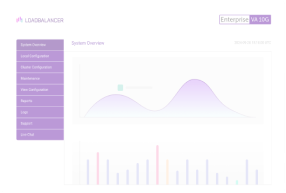Load balancing Scality ARTESCA
Benefits of load balancing Scality ARTESCA
Load balancing Scality ARTESCA provides High Availability (HA), scalability, and optimal performance:
- High Availability (HA): Load balancing is crucial for ensuring the storage environment remains always available and resilient to failures. A load balancer constantly monitors the health of all ARTESCA nodes in the cluster. If a server fails or becomes unresponsive, the load balancer automatically detects the issue and immediately reroutes client traffic away from the failed node to the remaining healthy servers. This minimizes downtime and ensures the storage endpoint remains accessible. It specifically enables robust failover for the S3-compatible API access point, which is the primary way applications interact with ARTESCA. This provides a single, highly available point of contact for clients, masking internal cluster issues.
- Scalability: Load balancing simplifies the process of expanding the ARTESCA cluster to meet growing data and performance demands. It allows you to add or remove ARTESCA nodes (servers) from the cluster without causing any downtime or disrupting service to users. The load balancer automatically starts distributing incoming traffic to newly added nodes. By distributing the workload evenly across all available resources, load balancing ensures that you are getting the most out of your entire infrastructure. This is critical for scale-out architectures like ARTESCA, preventing any single node from becoming a bottleneck (a “hot-node” problem).
- Optimal performance: By intelligently managing and distributing network traffic, load balancing helps maximize the throughput and minimize the response time of your object storage. It distributes client requests (reads and writes) across the multiple storage nodes, ensuring that the processing load is shared. This prevents any one node from being overwhelmed, leading to faster response times and higher concurrent access capability. Some load balancers can offer advanced features like SSL/TLS offloading, where the computational burden of encrypting and decrypting traffic is handled by the load balancer instead of the ARTESCA nodes. This frees up the storage nodes’ CPU cycles to focus purely on data storage and retrieval, further boosting overall performance.
About Scality ARTESCA
Scality ARTESCA is simple and secure S3 object storage software that seamlessly integrates with Veeam for immutable, ransomware-proof backups. It’s the only S3 object storage software designed to provide the strongest form of data immutability, plus 5 levels of end-to-end cyber resilience, providing unbreakable data protection for workloads such as Veeam.
For scale-out data services with stateless S3 API endpoints, Scality recommends using a three-node deployment as standard, which utilizes floating IPs for failover to provide high availability.

Why Loadbalancer.org for Scality ARTESCA?
Our long-standing partnership with Scality means this deployment guide isn’t theoretical; it has been field tested and rigorously validated by Scality experts. This means you can be completely confident that the solution described is robust, reliable, and backed by the real-world operational experience of a global leader in healthcare technology.
There are many different load balancers on the market, with different features, levels of support, and associated costs, so why do Scality recommend us?
- Partnerships – We have a proven track record with Scality, HPE and their partner network
- Experience – We have 20+ years’ experience optimizing complex object storage environments
- Intuitive WebUI – With our easy to use interface means you can deploy faster and manage your load balancer more easily
- High availability – Our Enterprise ADC provides S3 connector failover, storage server failover, advanced health checks, and multi-site failover
- Performance – Our load balancer can balance data load, and offers Direct Server Return, as well SSL offloading
- Scalability – We offer a number of different load balancer scaling and performance options for increased throughput, as well as a Site License that allows you to spin up as many load balancers as you like, at no extra cost
- Integrated GSLB – With our appliance GSLB comes as standard, straight out of the box, at no extra cost
- Validation – Our solution and step-by-step deployment guide comes pre-validated by Scality
- Tierless Support – Consultative, same-day, tireless support comes as standard
- No End-of-Life – Loadbalancer.org does not End-of-Life its virtual appliances, putting customers back in control of their product lifecycle
For more on the Scality and Loadbalancer partnership, check out these resources:
Loadbalancer optimizes S3 networks for HPE with Scality
Scality, HPE and Loadbalancer take the object storage market by storm
How to load balance Scality ARTESCA
Load balancing can be implemented in different ways, depending on the use case and the infrastructure:
- You can configure Data Virtual IPs in combination with DNS Round Robin. Data Virtual IPs are managed by ARTESCA, and are balanced across the running nodes of the cluster. They are not statically assigned to a specific node.
A guide on how to configure such DNS on Windows Server can be found here. - You can configure a load balancer in front of ARTESCA that will distribute the traffic flow to each node of the cluster.
Note
Do not use virtual IPs. Instead, configure your load balancer to point at the real IP on each node’s workload plane and use the health check endpoint to monitor the health of the nodes.
A health check endpoint exists on HTTPS (port 443) and HTTP (port 80) on path /healthz for every node data IP.
If using a load balancer, it needs to be configured as a TCP proxy, and no TLS termination on the load balancer.
Note
You can have multiple data IPs per node. In that case, you can pick any of them to configure the load balancer.

















